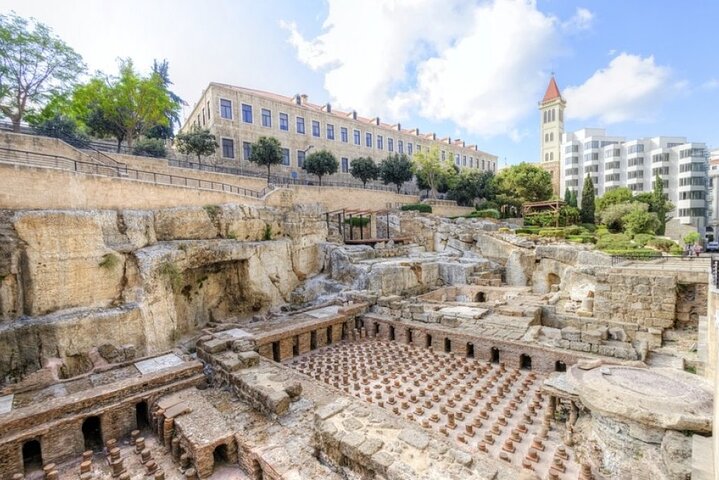Discover Lebanon’s rich history and stunning landscapes on a private tour to Beit El Din, Deir el Qamar, and Moussa Castle. Explore the opulent palace of Beit El Din, the charming village of Deir el Qamar, and the fairy-tale fortress of Moussa Castle. Join us for an unforgettable journey through centuries of heritage and breathtaking scenery.
Discover Lebanon’s rich history and stunning landscapes on a private tour to Beit El Din, Deir el Qamar, and Moussa Castle. Explore the opulent palace of Beit El Din, the charming village of Deir el Qamar, and the fairy-tale fortress of Moussa Castle. Join us for an unforgettable journey through centuries of heritage and breathtaking scenery.
- Beiteddine Palace - Beiteddine Palace, also known as the ‘House of Faith,’ is a 19th-century palace located in Beiteddine, Lebanon. It is the venue for the annual Beiteddine Festival and houses the Beiteddine Palace Museum. Emir Bashir Chehab II, who later ruled the Mount Lebanon Emirate, constructed the palace between 1788 and 1818. After 1840,…
- Beiteddine Palace - Beiteddine Palace, also known as the ‘House of Faith,’ is a 19th-century palace located in Beiteddine, Lebanon. It is the venue for the annual Beiteddine Festival and houses the Beiteddine Palace Museum. Emir Bashir Chehab II, who later ruled the Mount Lebanon Emirate, constructed the palace between 1788 and 1818. After 1840, the Ottomans used it as a government building, and during the French Mandate, it served as a local administrative office. In 1943, it was declared the president’s official summer residence. The palace suffered significant damage during the Lebanese Civil War. Today, parts of it are open to the public, while the rest remains the president’s summer residence. - Moussa Castle - Qasr Moussa, or Moussa Castle, narrates the story of a man who chased his dream of building his own castle. Situated on a hill between Deir El Kamar and Beiteddine in Lebanon, the castle reflects the beliefs and ideas of its builder, Moussa Al Maamari, who was born on July 27, 1931. He conceived the idea of building a castle at the age of 14 to impress a local girl he loved. - Fakhreddine’s Mosque - Fakhreddine Mosque, featuring an octagonal minaret, is located in Deir el Qamar, Lebanon. Built in 1493 and restored in the sixteenth century by Fakhreddine I, it is the oldest mosque in Mount Lebanon. - Saydet El Talle Church - The Church of Saidet et Tallé, translated as Our Lady of the Hill, is a significant historical and religious site in Deir el Qamar, dating back to the 15th century. Monk Nicolas Smisaati constructed the church over the ruins of an ancient Phoenician temple dedicated to the goddess Astarte, which was destroyed by an earthquake in 859. According to the Maronite Heritage website, a legend tells of a Druze Emir in Baakline who saw a light emanating from the hill of Dar El Kamar. He instructed his soldiers to dig in the land the next morning, saying, ‘If you find an Islamic symbol, build a mosque. If you find a Christian symbol, build a church.’ The soldiers found a rock with a cross on it, and beneath the cross were the moon and Venus, indicating that the site had once been a temple dedicated to the moon and Venus before becoming a church. - Deir el Qamar - Deir al-Qamar, meaning ‘Monastery of the Moon,’ is a village located southeast of Beirut, about five kilometers from Beiteddine Palace in the Chouf District of Mount Lebanon. Deir El Qamar was the first village in Lebanon to establish a municipality in 1864 and is the birthplace of many notable figures, including artists, writers, and politicians. The village was home to people of various religious backgrounds and featured a mosque, synagogue, and Christian churches. In 1860, Deir al-Qamar was destroyed during the civil war between Druze and Christians, during which the town was set on fire. Napoleon III sent a French contingent to rebuild it, reaffirming France’s historical role as protector of Christians in the Ottoman Empire, as established by a treaty in 1523. In 1864, Deir el-Qamar elected the first municipality in the Arab provinces of the Ottoman Empire. The village retains a picturesque appearance with typical stone houses and red tile roofs.

- Private transportation
- English Speaking Driver
- Hotel Pick up & Drop off
- In-vehicle air conditioning
- Private transportation
- English Speaking Driver
- Hotel Pick up & Drop off
- In-vehicle air conditioning
- Entrance fees to the sites
- Lunch
- Entrance fees to the sites
- Lunch
For a full refund, cancel at least 24 hours before the scheduled departure time.
For a full refund, cancel at least 24 hours before the scheduled departure time.














